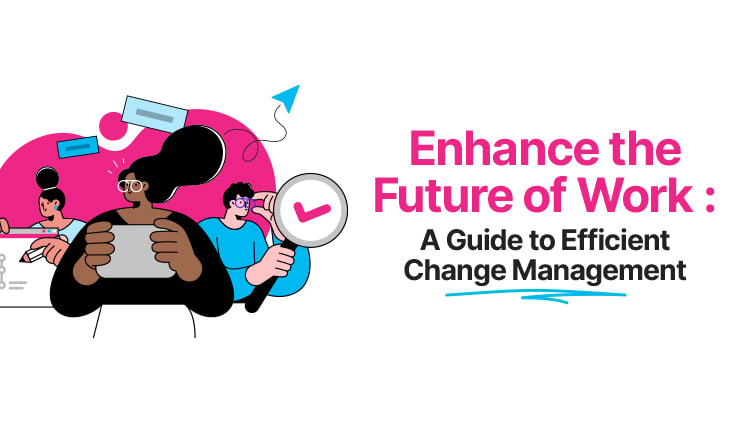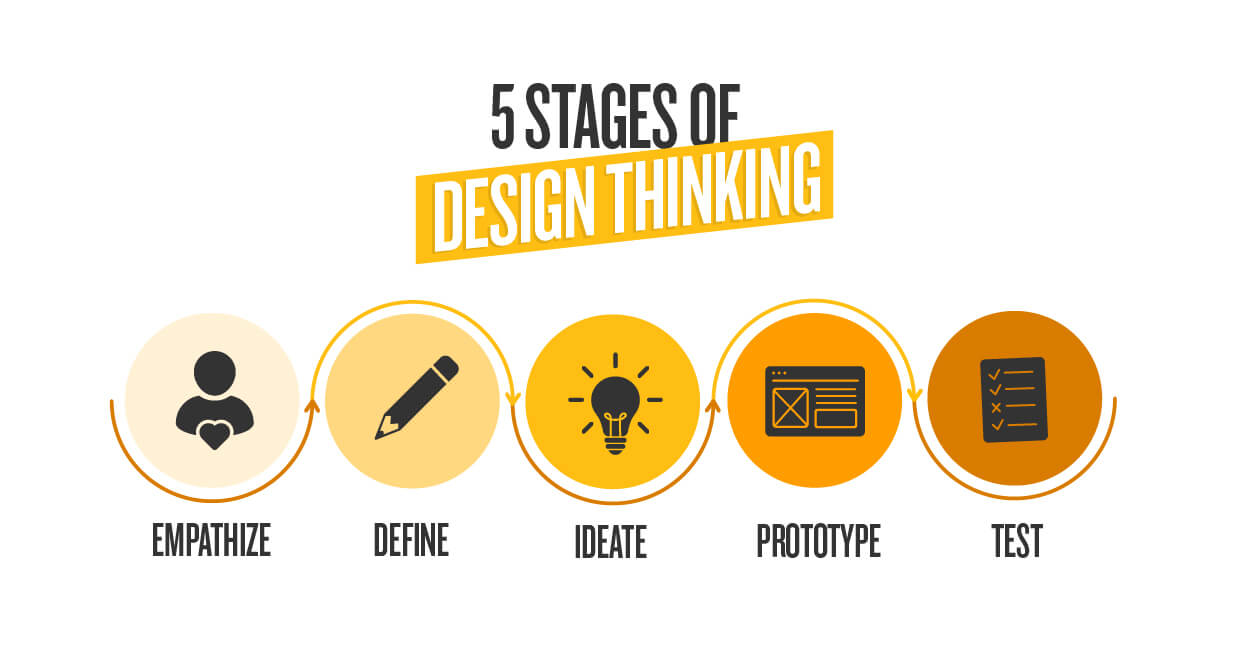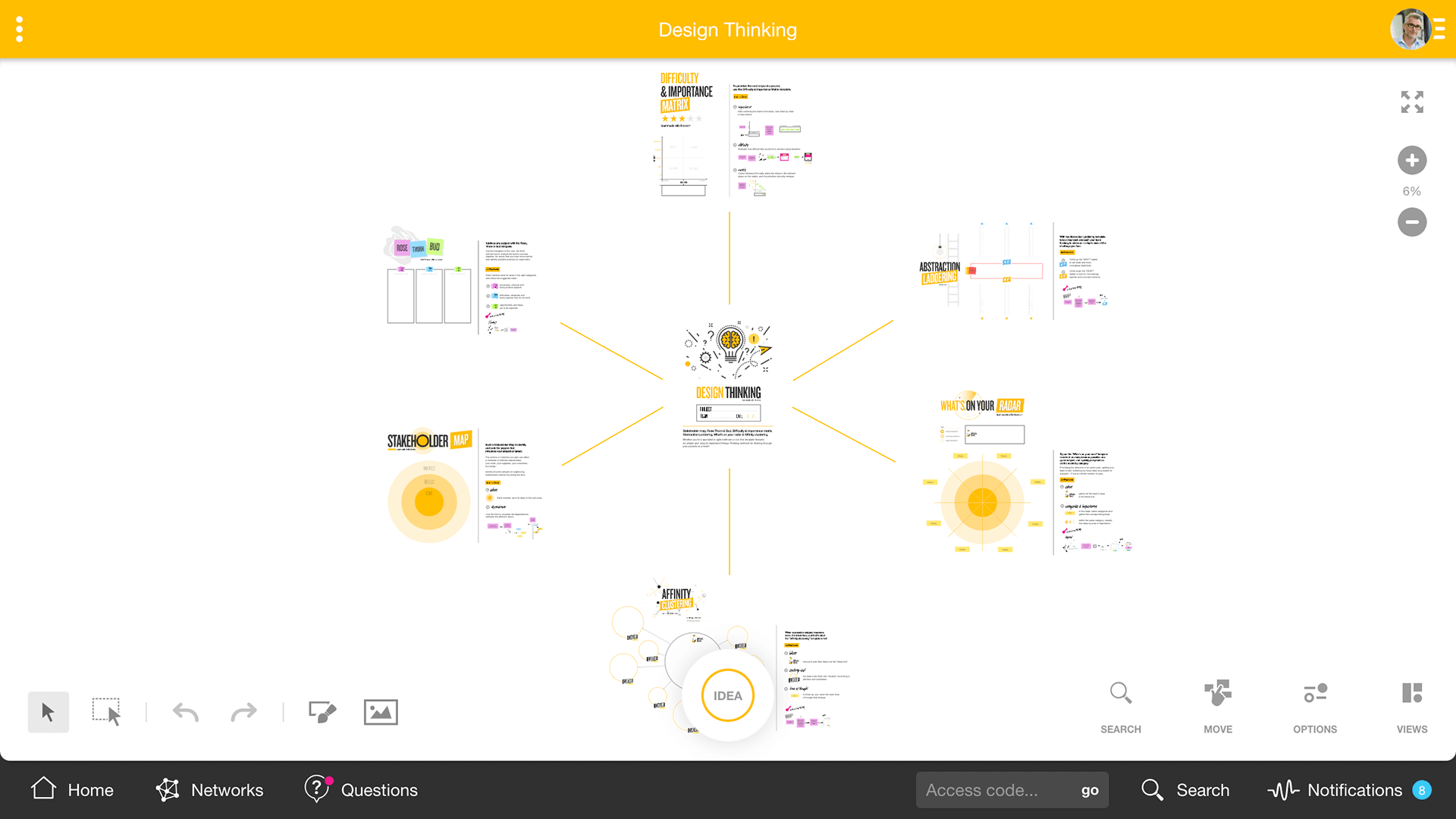5 steps for putting design thinking into action
Published on July 30, 2025
5 steps for putting design thinking into action
Design thinking is a model that can help you approach business problems from a different perspective – generally, that of your end user. Whether you are creating a new product, designing the ultimate user experience (UX), brainstorming a new ad campaign, or developing a promotional offer, design thinking can help to promote creativity and channel this into viable decisions and products.
In this article, we’ll look at useful design thinking tips, the ideology behind design thinking, and how you can apply it in your own business. In addition to these tips, you will also find some ready-to-use templates from Klaxoon.
When most people think of “design thinking”, they think of the five steps we’ve described in detail below – empathize, define, ideate, prototype, and test. By following these steps, you can structure your thoughts and work within particular projects, so that both you and your clients have a clear understanding of how things are progressing.
There is a lot more to design thinking than just these five steps, however. It’s also important to apply them with the right mindset, and to understand when and how they can help you make business decisions. So let’s take a look at their origins, and at the ideology that informs them
At the broadest level, design thinking is a way of organizing the processes that go into designing a viable product, service, or process. Though design thinking is often presented as a series of prescriptive steps for design teams to follow, in reality it is more of a framework for catalyzing creativity than it is an algorithmic, strictly linear method.
The term was first popularized by Tim Brown, David Kelley, and Roger L. Martin. The concepts of design thinking were then developed more by Stanford’s d.School, to the point that the entire school is now dedicated to design thinking principles.
Brown, who is the CEO of IDEO, has given one of the most succinct definitions of this approach: “Design Thinking is a human-centered approach to innovation that draws from the designer’s toolkit to integrate the needs of people, the possibilities of technology, and the requirements for business success.”
In this definition we see the three key elements of design thinking:
Design thinking is a powerful tool, but only in certain circumstances. Some business problems are relatively easy to solve using mathematical or logical techniques, and some are not. The latter type of problem is often called a “Wicked Problem” – defined as a problem that is unique, and has no easily-obtainable algorithm that can solve it.
Knowing how to improve your design thinking is crucial whenever you are faced with a “Wicked Problem,” but particularly when you are having difficulty reconciling your own thinking with your clients’ needs. Design thinking can help you to see more easily how your process will result in a viable outcome, and can provide a framework for you and your client to work toward this collaboratively.
Those who study design thinking at Stanford are first taught about the ideology that underpins design thinking. Learning design thinking techniques can help you to apply it in a more “natural” way, and to eventually do so in a way that doesn’t even require you to record this.
The ideology of design thinking starts with the book Design of Business by Roger L. Martin, in which he discusses the idea of a “knowledge funnel”. He uses this funnel to conceptualize the three stages of solving a business problem:
In addition to this linear process, some design thinking practitioners also see the approach as a way of resolving the friction that can sometimes arise between two different types of thinking (and thinkers). Analytical thinkers, they argue, analyze the past in order to predict the future, and value reliability. Intuitive thinkers look to the future, and tend to value creativity.
The iterative process of design thinking – as we shall see – forms a compromise between these innovative approaches. The central idea is that by using the design thinking template, the benefits of both types of thinking can be realized.


When applying the design thinking methodology, most practitioners will define five relatively discrete steps to follow. However, it’s important to recognize that design thinking is not a linear process, and so therefore these “steps” need not be followed in the order below. In fact, as you become more familiar with each of them, you will find that each of them informs the other in a continual, iterative process.
But as we’ll soon see, design thinking doesn’t just have to be used for creative purposes. It can also be used to help identify and rank the players who you can categorize in your Stakeholder map, or you can also prioritize your tasks with the aid of the Difficulty and Importance Matrix.


The 5 Stages of Design Thinking
One of the most important parts of design thinking is understanding what your audience needs. In design thinking, this understanding is called “empathy” in order to stress that it goes far beyond reading a design brief. In design thinking, you must be able to see what the product looks like from the perspective of your audience, and their likely reaction to it.
Most design thinkers will attempt to access this via “empathy interviews”. These are detailed, structured interviews that seek to ascertain not just exactly what your audience needs from you, but also how they are emotionally connected to the issue your product is designed to address.
After you have collected information on your audiences’ needs, you can begin to define the solution to the problem at hand. It’s important, at this stage, to make sure that you are drawing your conclusions directly from what your audience has told you, rather than your own preconceptions.
At this point, it can also be helpful to have a few subsidiary tools. Activities like “innovation sprints” can be extremely useful in turning your audience empathy into well-defined propositions. Remember that at this stage, you are not looking to generate a single solution to the problem at hand, but rather to speculate about the linkage between your audience and their desired solution, and how you can best achieve this.
The ideation phase in design thinking is all about brainstorming. This might be too limited a term, however, for the way in which ideation occurs in design thinking.
Ideation, in design thinking, rests on a number of core principles. The first is that this stage is an expansive one, rather than one of filtration – the idea is to produce as many ideas as possible, rather than refine them into finished products.
Secondly, most teams will use a pre-written set of constraints to further spur creative thinking during the ideation phase. You can ask your team, for instance, to ideate within set budgets, or to think of ideas that could be delivered in a remote environment.
A good tool to use at this stage is our Affinity Clustering ideation session, where you or your team can generate ideas and then organize those ideas based on their resemblance. This way, the key points will begin to appear progressively to more effectively outline and brainstorm your concept or idea.
Once you have generated dozens of ideas for your product, ad, or service, it’s time to start prototyping them. Prototyping is often misunderstood by those new to design thinking, because when they think of “prototype” they think of an early stage of a product. In reality, almost anything can have a “prototype”; a tagline, a print ad, even an idea.
There are two sub-stages within this stage. The first is one of refining the ideas that have been generated by the ideation phase of your process. You should, as far as possible, involve the entire team in deciding which of these ideas to take forward, because teams that have bought into particular ideas are more likely to be passionate about carrying them out. It’s also important to be realistic about how many of your ideas you can test effectively – be ruthless, and cut out all but the very best ideas, and you’ll save a lot of time and wasted effort further down the line.
The second substage here is to build your prototype. It’s important, at this stage, to not over-complicate your product. If you have to call on external teams to prototype it, you are putting too much work into this phase. It’s better to build something from construction paper, pipe cleaners, and masking tape – or their software or mental equivalents – than to try and build a finished product at this stage.
And if you are designing something even more abstract – a process, or an interactive experience – estimate this as best you can with the tools available to you. The aim, at this stage, is to spot any major flaws with your ideas before you go on to the next stage.
Testing your prototypes is the “final” stage of conducting your design thinking process. At this point, you’re going to take your prototype into the field and ask users what they think about it. A good place to start this process is with the clients and audiences that you’ve previously conducted empathy interviews with. Because they are already involved in the process, they are likely to have insights on what you’ve come up with that can greatly contribute to your design process.
You may be surprised, at this stage, in regards to just how many fundamental problems your design exhibits. As you may find, users are frustratingly great at spotting flaws in your ideas that render them completely unsuitable as a solution to the problem you’ve defined!
But take heart. The reason why you are using a design thinking approach is precisely to catch these issues at a prototype stage. This is why testing is only ever the “final'' stage of just one iteration. Most designers, having completed a little testing, will go back to the design stage, and iteratively improve their solution until it is perfect.
Design thinking is so effective – in comparison to some other approaches relating to product design – because it focuses on the end user. This means that the products produced by the process fit the needs of their target audience much more closely than those informed by a design team’s assumptions.
Design thinking is best used for addressing problems that are not very well defined. It accomplishes this through creating new ideas via brainstorming sessions and by re-framing the problem as a whole in a more user-centered way.
There are a number of courses available from experienced design thinking practitioners that can teach you the basics of design thinking, but nothing beats trying it out yourself as a way of learning the key techniques. Grab a textbook on the approach, explain its key principles to your team, and start running through the stages we’ve defined above. Before you know it, you’ll be applying these stages to every aspect of your designs, even without thinking about it.
Check out the design thinking templates from Klaxoon as well.
Design thinking is unique in that it focuses on solving problems from the perspective of the user: think of it as taking the opportunity to really step into our users’ shoes, so you can and understand them on a new level. This leads to products, services, and processes that are more intuitive, and more in step with what your audience needs.


Ready-to-Use Design Thinking Methods in Klaxoon's Template Library
Design thinking is a powerful tool for designing a wide variety of customer-facing products, services, and materials. At its core, the design thinking process is based on a deep understanding of the needs of your audiences, and provides a way of structuring your design work toward those needs.
The five stages we’ve described above provide the core stages of design thinking, but there is much more to learn. Take a look at Klaxoon’s design thinking page to start your own journey in this exciting new discipline.
Unlock your teamwork potential